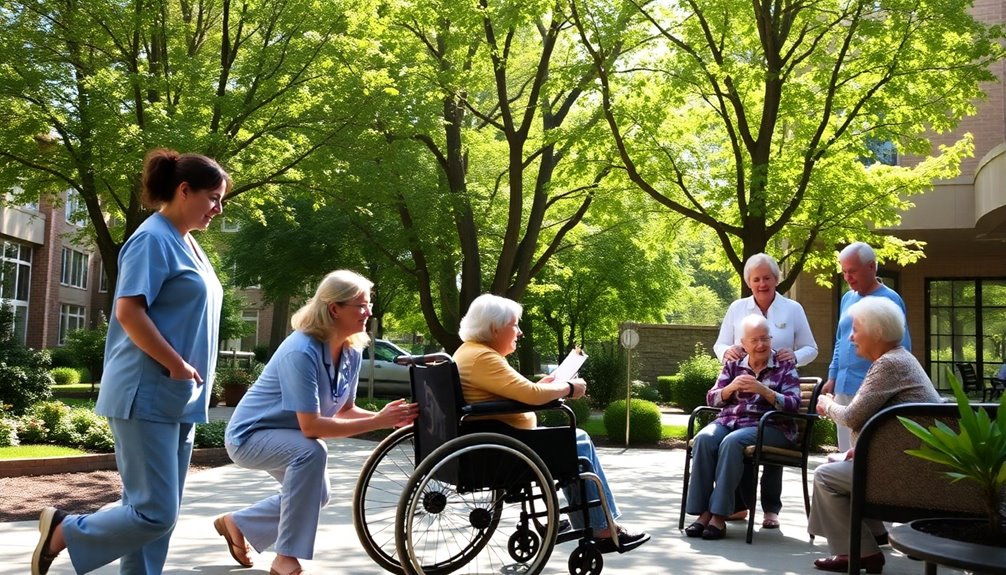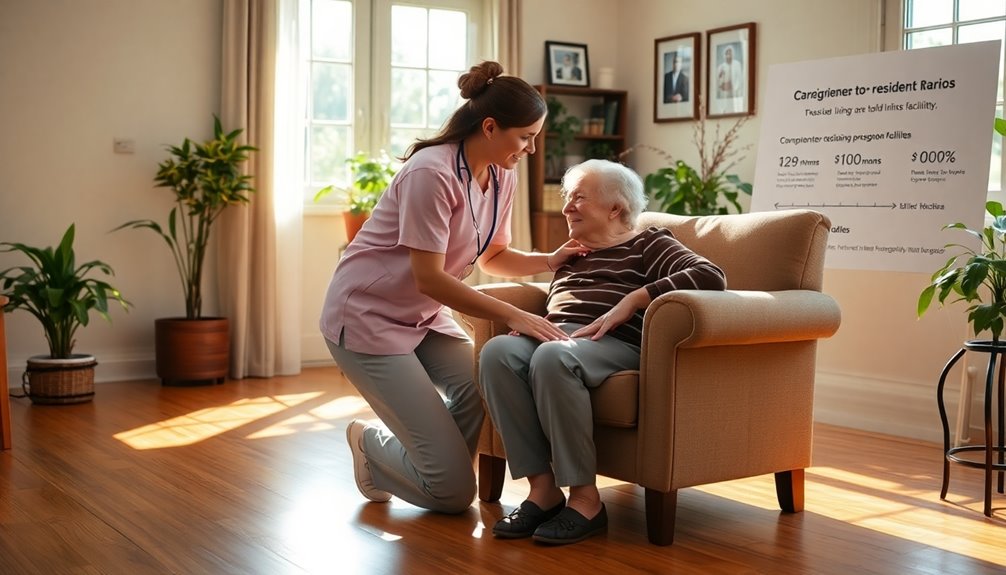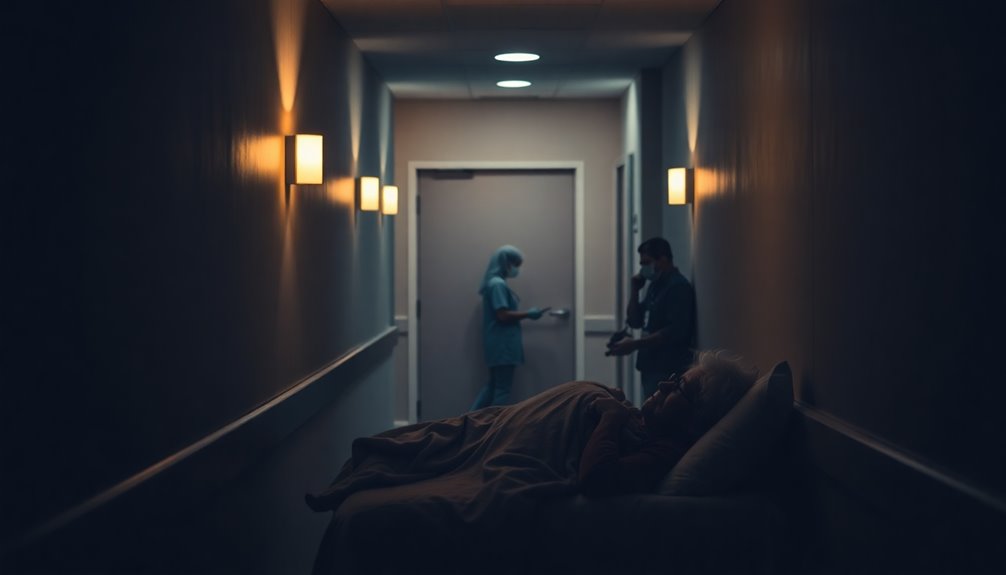In assisted living, the caregiver-to-resident ratio typically ranges from 1:6 to 1:20. Most facilities operate with about 1 caregiver for every 8 residents during the day, while the night shift can stretch to 1:15. If residents have higher care needs, you might see ratios closer to 1:5 or 1:6. Understanding specific needs and local regulations can help you find the best fit for care. There's more to explore about caregiver qualifications and training requirements.
Key Takeaways
- Staff-to-resident ratios in assisted living typically range from 1:6 to 1:20, depending on care needs and shift times.
- Day shifts commonly have a caregiver ratio of about 1:8, while night shifts can extend to 1:15.
- Higher caregiver ratios, such as 1:5 or 1:6, are preferred for residents with complex care requirements.
- Local regulations influence minimum staffing requirements, with only twelve states mandating specific ratios.
- Adequate staffing levels are crucial for ensuring quality care and resident satisfaction in assisted living facilities.
Understanding Staff-to-Resident Ratios in Assisted Living

When considering assisted living, it's important to understand staff-to-resident ratios, which typically range from 1:6 to 1:20. These ratios can greatly impact the quality of care you or your loved one receives.
During day shifts, the common ratio is about 1:8, allowing caregivers to provide more personalized care. At night, this can stretch to 1:15, which may affect monitoring of residents.
Families often look for lower staffing ratios to guarantee closer attention for those with higher care needs. State regulations can also influence these staffing ratios, with some states establishing minimum requirements.
Understanding individual resident needs will help you choose the right assisted living facility that aligns with the level of care required for the best support. Additionally, financial considerations for elderly care can play a significant role in determining the type of assisted living facility that meets both care and budgetary needs.
Factors Influencing Caregiver Ratios

When you consider caregiver ratios, several key factors come into play.
The specific care needs of residents, the size of the facility, and local regulatory requirements all shape how many caregivers are needed.
Understanding these influences can help you appreciate the complexities behind staffing in assisted living environments.
Resident Care Needs
Understanding resident care needs is essential for determining the appropriate caregiver ratios in assisted living facilities. The staff-to-resident ratio directly impacts the quality of care provided.
For residents with complex care requirements, like advanced dementia, a caregiver-to-resident ratio of 1:5 or 1:6 is often necessary to guarantee personalized attention. More independent seniors may thrive in communities with fewer staff, while those needing assistance with daily activities benefit from closer support.
Facilities must consider individual care levels and future needs to maintain confidence in available care. Higher caregiver ratios typically correlate with better health outcomes and increased engagement, assuring timely responses to needs and enhancing overall quality of life for residents. Additionally, understanding narcissistic behaviors can be crucial in ensuring that residents with specific psychological needs receive appropriate support.
Facility Size Impact
The size of an assisted living facility plays an essential role in determining the caregiver-to-resident ratios necessary for effective care.
Larger facilities often require more caregivers to maintain adequate staffing levels, with ratios ranging from 1:6 to 1:20, depending on residents' care needs. This variation allows for tailored personal care and specialized programs that meet different complexities among the population.
In contrast, smaller facilities can function with fewer caregivers, enabling lower staff-to-resident ratios that enhance personalized attention.
Additionally, the physical layout impacts staffing needs; larger spaces demand more caregivers for effective monitoring and support across various areas.
Ultimately, finding the right balance in facility size and staffing is critical for delivering quality care to residents.
Regulatory Requirements Compliance
As you consider the caregiver-to-resident ratios in assisted living facilities, it's important to recognize how regulatory requirements shape these numbers. State regulations often dictate minimum staffing levels, which directly impact caregiver ratios. Facility administrators must navigate these rules while considering residents' care needs, as more complex conditions necessitate a higher staff-to-resident ratio for quality care.
| State Regulations | Minimum Staffing Levels | Impact on Caregiver Ratios |
|---|---|---|
| Vary by state | Defined by law | Affects adequate support |
| Consider turnover | Requires qualified staff | Influences care quality |
| Facility size | Based on layout | Determines staffing needs |
Ultimately, high turnover rates can undermine compliance and lead to staffing shortages, affecting care quality.
The Importance of Individualized Care Needs

When selecting an assisted living facility, recognizing each resident's unique care needs is essential for guaranteeing their well-being. A proper staff-to-resident ratio directly influences the quality of care provided.
For those requiring frequent assistance, lower ratios are more beneficial, while relatively independent seniors may thrive with higher ratios that allow for more person-centered care. Understanding individual resident needs helps families choose a facility that offers tailored support and adequate health services, enhancing overall resident satisfaction.
Adequate staffing levels guarantee caregivers can meet diverse requirements, building confidence in the care available. By prioritizing individualized care, facilities can better equip themselves to support residents' unique situations, leading to improved outcomes and satisfaction for everyone involved.
Night Shift Staffing and Ratios

While many residents may be asleep during the night, guaranteeing adequate staffing in assisted living facilities remains vital for their safety and well-being.
Night shift staffing ratios typically range from 1:10 to 1:15, meaning there's a higher number of residents per caregiver compared to daytime. The average staff-to-resident ratio is often lower due to decreased resident activity and care demands.
However, many facilities guarantee at least two caregivers are on-site to handle emergency response and maintain safety. Effective night shift staffing is essential for monitoring residents, especially those with higher care needs or medical conditions.
Families should ask about caregiver-to-resident ratios during night shifts to guarantee adequate care for their loved ones.
Questions to Ask When Choosing an Assisted Living Community

When choosing an assisted living community, it's essential to ask about the caregiver-to-resident ratios for both day and night shifts.
You'll also want to verify that caregivers are CPR certified and understand the availability of medical staff for emergencies.
These questions will help guarantee your loved one receives the support they need.
Caregiver Ratio Inquiry
How can you guarantee your loved one receives the best care in an assisted living community? Start by inquiring about the caregiver-to-resident ratios for both day and night shifts, as these can vary considerably.
Ask if at least two caregivers are on-site at all times to guarantee adequate supervision and prompt emergency response. Confirm that caregivers are CPR certified and check on the availability of medical staff for emergencies.
It's essential to understand how the community addresses individualized care needs when determining staffing levels, as this greatly influences the quality of care.
Finally, discuss potential future care requirements and how the facility plans to adapt its support as residents' needs evolve over time.
Staffing Certifications Verification
Confirming your loved one receives quality care in an assisted living community starts with verifying the staff's certifications and training. You should ask about the caregivers' qualifications, such as Certified Nursing Assistant (CNA) or CPR certifications, to confirm their readiness for resident care.
Inquire about ongoing training programs that keep staff updated on emergency procedures and resident rights.
- A well-trained caregiver can make all the difference.
- Knowing the facility conducts background checks provides peace of mind.
- Stable staff retention guarantees consistency in care.
Additionally, verify if the community documents these certifications for regulatory compliance.
These steps are crucial for maintaining quality standards in Assisted Living Services and confirming your loved one's safety and comfort.
Caregiver Qualifications and Training Requirements

While assisted living communities often have less stringent staffing requirements than nursing homes, understanding caregiver qualifications and training is vital for families seeking the right environment for their loved ones.
Caregiver qualifications can vary considerably based on state regulations, which may mandate specific training hours, CPR certification, and thorough background checks. Many caregivers receive on-the-job training rather than formal certifications, but some facilities hire certified nursing assistants, who’ve undergone more extensive training. Additionally, potential caregivers should research the specific requirements in their state to ensure compliance with local laws and standards. Resources and training programs are widely available to help individuals learn how to become a caregiver, providing both necessary knowledge and skills. Whether through community colleges or specialized training centers, aspiring caregivers can find various pathways to enhance their qualifications and readiness for the role.
These qualifications play an essential role in guaranteeing a proper staff-to-resident ratio and meeting facility standards in health care. It's advisable to consult directly with assisted living communities about their caregiver training requirements to ascertain staff are well-prepared to address residents' needs effectively.
State Regulations Impacting Staffing Ratios

State regulations play an essential role in determining staffing ratios in assisted living facilities, impacting the level of care residents receive. While twelve states mandate minimum staffing levels, thirty-eight don't specify ratios, leaving care quality to local regulations.
You might find that some states require at least one caregiver on-site when residents are present, guaranteeing adequate supervision based on resident needs. Additionally, caregiver qualifications can vary, affecting overall care.
- Lack of proper staffing leads to unmet needs.
- Inconsistent regulations can compromise safety.
- Quality care is often tied to dedicated staffing.
Regular inspections guarantee compliance with these staffing requirements, directly influencing the staff-to-resident ratio and the quality of care provided in your loved one's assisted living facility.
Strategies for Improving Staffing Levels in Assisted Living

To enhance staffing levels in assisted living facilities, administrators can adopt a variety of strategic approaches that directly address workforce challenges. Implementing scheduling software can streamline staff management and reduce conflicts, while providing ongoing training boosts job satisfaction and retention. Competitive compensation packages can lower turnover rates, ensuring a stable workforce that meets resident care needs. Engaging in community outreach helps attract qualified caregivers, expanding your talent pool. Additionally, regular assessments of resident care needs allow for adjustments in staffing levels and improve the caregiver-to-resident ratio.
| Strategy | Benefits | Key Focus |
|---|---|---|
| Scheduling Software | Reduces conflicts | Caregiver availability |
| Ongoing Training | Increases job satisfaction | Retention and skill enhancement |
| Community Outreach | Attracts qualified caregivers | Expanding talent pool |
Frequently Asked Questions
What Is the Ratio of Caregivers to Residents?
When considering caregiver-to-resident ratios, you'll find that the typical staffing is about 1 caregiver for every 8 residents during the day and can stretch to 1 for 15 at night.
However, these numbers can shift based on individual care needs and facility policies.
It's essential to ask about these ratios when selecting a community, as they can greatly influence the quality of care your loved one receives.
Always prioritize their specific requirements.
What Is the Nurse to Patient Ratio in Assisted Living?
In assisted living, the nurse-to-patient ratio typically ranges from 1 nurse for every 10 to 15 residents during the day shift.
You might find some facilities offering a more favorable ratio of 1:8 during peak hours to address complex health needs.
At night, this ratio can increase to about 1:15 or more, reflecting lower activity levels.
It's essential for ensuring timely medical response and overall resident safety, so keep this in mind when considering options.
How Often Should You Visit Your Parents in Assisted Living?
You should aim to visit your parents in assisted living at least once a week to maintain emotional connections and monitor their well-being.
Try visiting at different times of the day to see how care and activities vary. Engaging with caregivers during your visits gives you an opportunity to ask about their needs and the support they're receiving.
Participating in community events can enhance their social life and give you valuable insights into their environment.
What Is the Ratio of Staff to Residents in a Care Home?
In a care home, the staff-to-resident ratio typically averages around 1:8, meaning for every eight residents, there's usually one staff member available.
During night shifts, this can rise to about 1:15 due to fewer activities.
When you're choosing a facility, pay attention to these ratios, as lower numbers often lead to better care and more personalized attention for residents.
Ultimately, the specific needs of residents play a big role in determining these ratios.
Conclusion
In assisted living, finding the right caregiver-to-resident ratio is like searching for the perfect balance on a seesaw—it's essential for ensuring everyone's well-being. As you evaluate communities, remember that individualized care, staff qualifications, and state regulations all play a role in shaping these ratios. By asking the right questions and understanding your loved one's specific needs, you can make an informed choice that promotes a safe, supportive environment for them to thrive.









